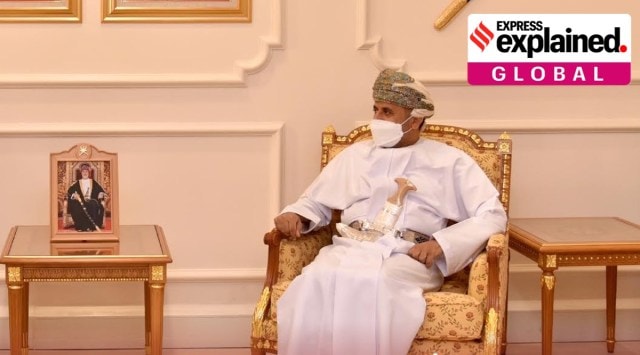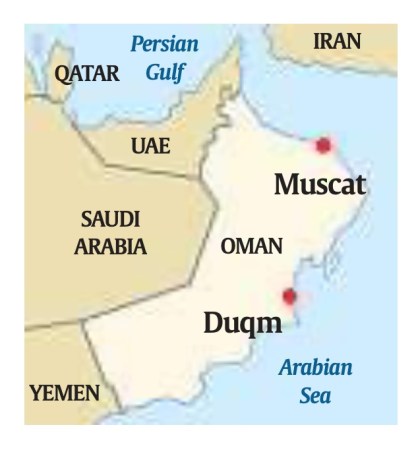Al Zaabi, the Secretary General of Ministry of Defence of the Sultanate of Oman, is the executive head of the Omani defence establishment as the Minister-in-charge is held by the Deputy Prime Minister Sayyid Shihab.

Zaabi will be in Delhi to co-chair the Joint Military Cooperation Committee (JMMC) with Defence Secretary Ajay Kumar. The JMCC is the highest forum of engagement between India and Oman in the field of defence that evaluates and provides guidance to the overall framework of defence exchanges between the two sides. The JMCC is expected to meet annually, but could not be organised since 2018 when the meeting of the 9th JMCC was held in Oman.
Coming as it does after a hiatus of three years and after the pandemic period, the 10th JMCC is expected to comprehensively evaluate the ongoing defence exchanges and provide a roadmap for further strengthening defence ties in the coming years.
Why is Oman important from a defence and strategic point of view?
Oman is India’s closest defence partner in the Gulf region and an important anchor for India’s defence and strategic interests. Defence cooperation has emerged as a key pillar for the robust India-Oman strategic partnership. Defence exchanges are guided by a Framework MOU which was recently renewed in 2021.
Oman is the only country in the Gulf region with which all three services of the Indian armed forces conduct regular bilateral exercises and staff talks, enabling close cooperation and trust at the professional level. Oman also provides critical operational support to Indian naval deployments in the Arabian sea for anti-piracy missions.
Story continues below this ad
Bilateral training cooperation between the two sides is also robust with Omani forces regularly subscribing to training courses in India both at professional as well as higher command level. Indian armed forces also subscribe to the Staff and Command courses conducted at NDC, Oman. Oman also actively participates in the Indian Ocean Naval Symposium (IONS).

Is there a history of India-Oman ties?
Oman, for many years, was ruled by Sultan Qaboos bin Said al Said, who was a friend of India.
Sultan Qaboos, the longest-reigning leader of the modern Arab world, died in January ‘2020 at the age of 79.
He was a man who was, as a student, taught by Shankar Dayal Sharma who went on to become the President of India. Sultan Qaboos’s father, an alumnus of Ajmer’s Mayo College, sent his son to study in Pune for some time, where he was former President Shankar Dayal Sharma’s student. He completed a part of his early education from a private institution in Pune.
Story continues below this ad
With the demise of Oman’s Sultan Qaboos bin Said al Said, India lost a key friend and partner in the Gulf region where it has vital stakes.
Prime Minister Narendra Modi had condoled the demise of Sultan Qaboos and described him as a beacon of peace for the region.
Modi had met Oman’s Sultan Qaboos in February 2018, when the two countries signed a strategic agreement for using the strategically-located Duqm port.
An Indian diplomat told The Indian Express from Muscat, “He had very fond memories from his student days…and that is the reason he had been very generous towards the Indian community and India’s requests for help.”
Story continues below this ad
The Government of India announced national mourning for one day on January 13, 2020 in his honour. Gandhi Peace Prize 2019 was conferred on late HM Sultan Qaboos in March 2021, in recognition of his leadership in strengthening the ties between India & Oman and his efforts to promote peace in the Gulf region.
So, Sultan Qaboos had helped India in what ways?
Sultan Qaboos had played a role in the release of Father Tom Uzhunnalil, the Vatican priest who was abducted in Yemen in March 2016 and released in September 2017. Sultan Qaboos was reportedly in constant touch with parties from Yemen as well as the Ministry of External Affairs during the negotiations.
In the past also, Sultan had intervened to get hostages released — three American hikers jailed in Iran on espionage charges were released, a Canadian national Dr Homa Hoodfar who had been imprisoned in Iran and was released in September 2016, he also helped secure the release of unidentified hostages from Germany and Australia, from Yemen.
Modi, during his visit in February 2018, had tapped into the “personal connect” of Oman’s Sultan. He had met Sultan Qaboos at Bait Al Barakah Royal Palace for a special dinner and discussed the strategic relationship.
Story continues below this ad
With Sultan Qaboos’ demise, India is engaging with the new ruler, Haitham bin Tariq, Oman’s culture minister and the 65-year-old cousin of late Sultan Qaboos, for being a generous benefactor for the Indian community.
How many Indians are there in Oman?
There are about 6.2 lakh Indians in Oman, of which about 4.8 lakh are workers and professionals. There are Indian families living in Oman for more than 150-200 years. Thousands of Indians are working as doctors, engineers, chartered accountants, teachers, lecturers, nurses, managers among other professionals.
Apart from the welfare of the Indian community, what’s the strategic imperative?
Story continues below this ad
In a strategic move to expand its footprint in the Indian Ocean region, India has secured access to the key Port of Duqm in Oman for military use and logistical support. This is part of India’s maritime strategy to counter Chinese influence and activities in the region. This was one of the key takeaways of Prime Minister Narendra Modi’s visit to Oman in February ‘2018.
He had met Sultan of Oman Sayyid Qaboos bin Said Al Said and an annexure to the Memorandum of Understanding on Military Cooperation was signed between the two countries. Sources said following this pact, the services of Duqm port and dry dock will be available for maintenance of Indian military vessels.
What’s the significance of the Duqm port?
The Port of Duqm is situated on the southeastern seaboard of Oman, overlooking the Arabian Sea and the Indian Ocean. It is strategically located, in close proximity to the Chabahar port in Iran. With the Assumption Island being developed in Seychelles and Agalega in Mauritius, Duqm fits into India’s proactive maritime security roadmap.
Duqm has seen a rise in Indian activities. In recent years, India had deployed an attack submarine to this port in the western Arabian Sea.
Story continues below this ad
A Shishumar-class submarine entered Duqm along with naval ship INS Mumbai and two P-8I long-range maritime patrol aircraft. India gets access to strategic Oman port for military use, reconnaissance aircraft. The naval units were on a month-long deployment with the aim of enhancing surveillance and cooperation.

Following Modi’s visit to Oman, the joint statement said the two sides noted that the MoU on Military Cooperation, signed in 2005 and renewed in 2016, has provided the general framework to strengthen bilateral defence ties. India and Oman noted that the MoUs on cooperation in maritime security and between Coast Guards of the two countries, signed in May 2016, have provided a firm foundation for deepening institutional interactions. “Both sides expressed satisfaction at the signing of an annexure to the existing MoU on Military Cooperation between the defence ministries,” it said.
The joint statement had said the Indian side thanked Oman for facilitating operational visits by Indian Naval ships and aircraft as well as Indian Air Force aircraft to various ports and airports. “Recognising their common responsibility towards promoting regional peace and security, the two sides underlined the importance of further cementing bilateral strategic engagement, especially in the areas of security and defence,” it said.
It also said that the two sides expressed satisfaction at the ongoing bilateral security collaboration in the fields of counter-terrorism, information-sharing and capacity-building, and the Prime Minister appreciated the support extended by Omani security agencies on “specific issues of security concern to India”.
Are there other players?
Story continues below this ad
In August 2017, Oman signed an MoU with the United Kingdom that allowed the Royal Navy to use the Port of Duqm. The agreement allows UK access to facilities at Duqm, and among the vessels that will be allowed to dock at the port is the HMS Queen Elizabeth aircraft carrier, the largest ship in the British Navy.
What other activities is India doing at the Duqm port?
The Port of Duqm also has a special economic zone, where about $1.8 billion investments are being made by some Indian companies. The Adani group had signed an MoU with Duqm port authorities in recent years.
In the context of strategic oil reserves near Duqm, India had extended an invitation to Oman to participate in building strategic oil reserves in India.
So, what’s on the agenda of the Oman defence official’s visit?
On the sidelines of the JMCC, Zaabi is expected to call-on Defence minister Rajnath Singh and will also be given an exposure to the Indian defence production industry for possibilities of procurement and joint production.
Newsletter | Click to get the day’s best explainers in your inbox
His visit will be followed by a series of high profile defence engagements in the month of February that will include back-to-back visits to India by the Chief of the Royal Navy of Oman (RNO), and the Chief of the Royal Air Force of Oman (RAFO), staff talks between Indian Navy and CRNO, and a bilateral Air Force exercise in Jodhpur.
The visits of the Naval and Air Force Chiefs of Oman are taking place after a gap of 5 years and will enable a high level re-engagement between the forces of two sides. The bilateral Air Force exercise is annual and this year will feature the participation of over 150 personnel from the Oman side.










































